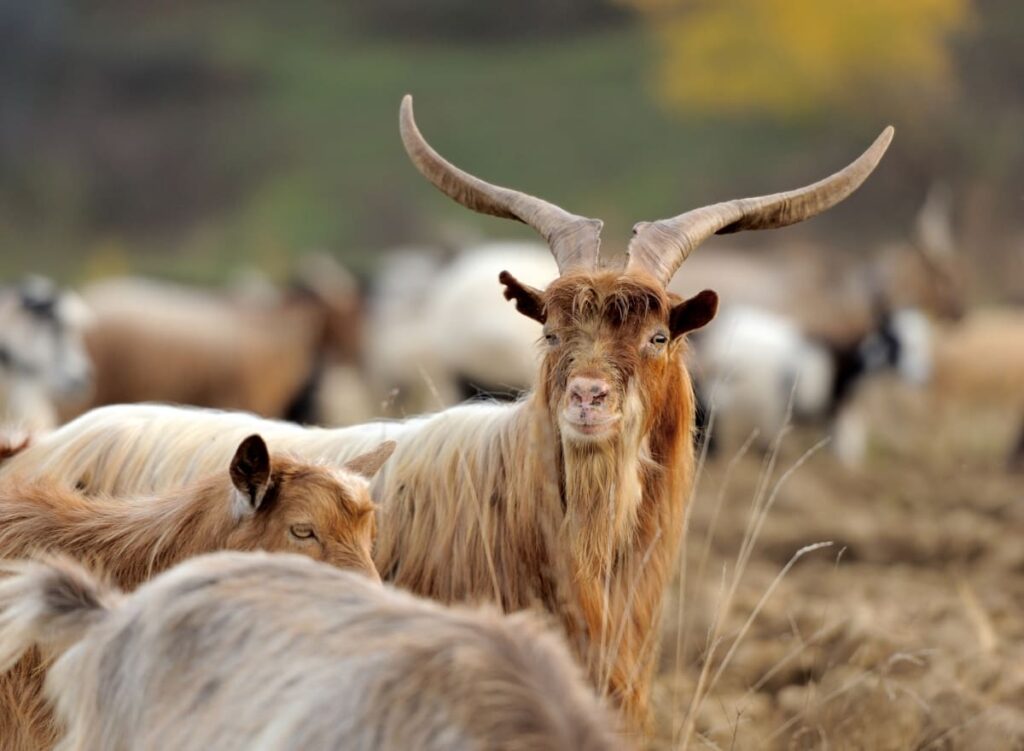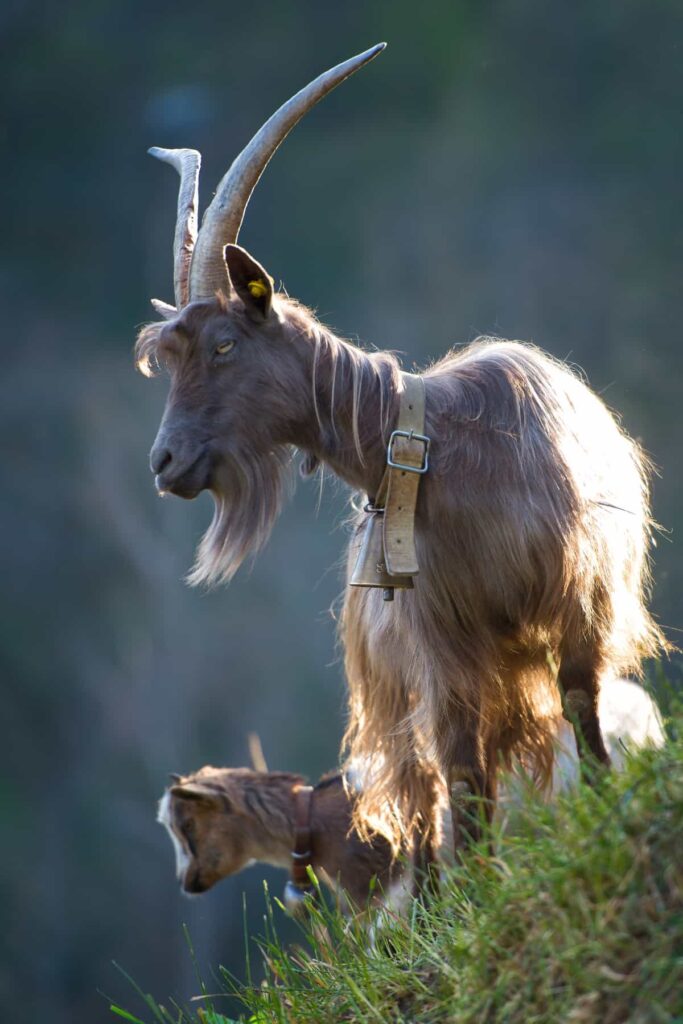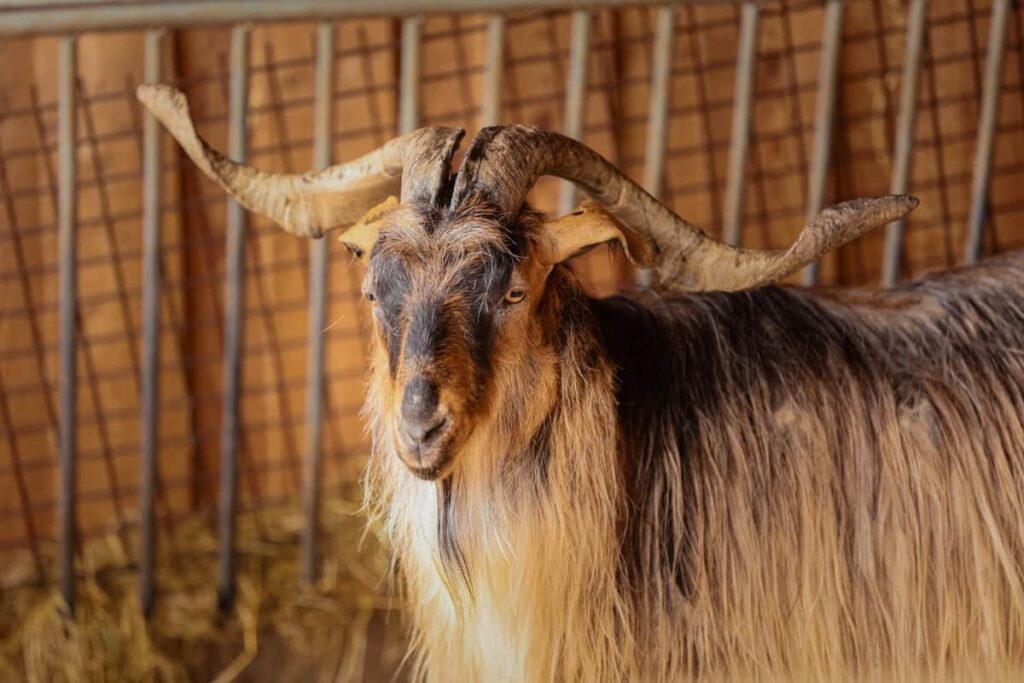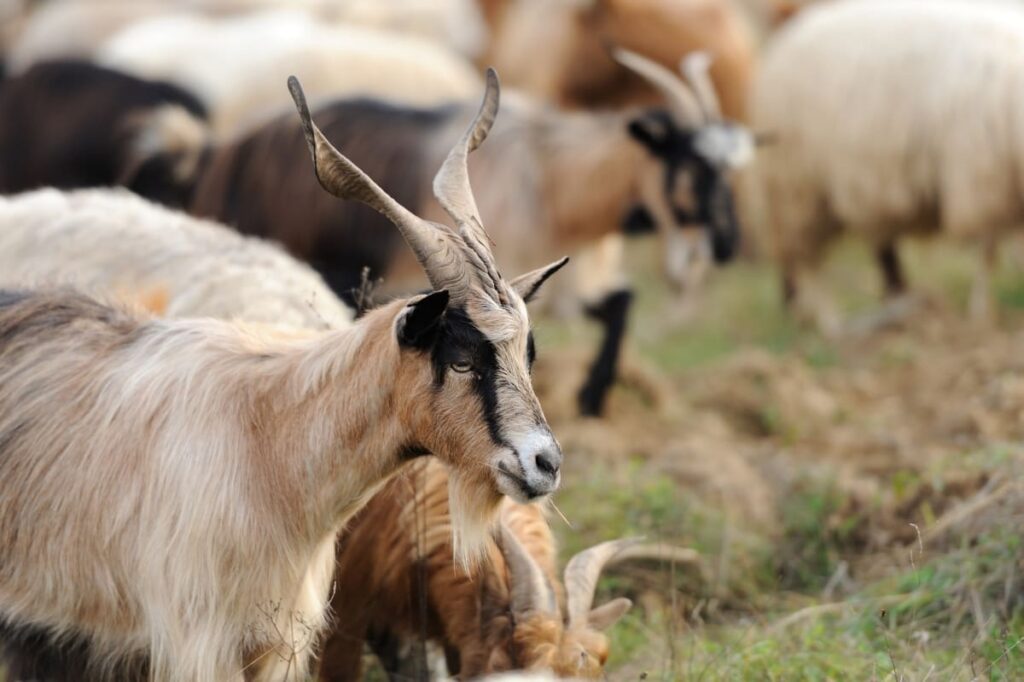The Chyangra Goat, also known as the Himalayan Goat, is a mountain goat breed that calls the high altitudes of the majestic Himalayan region its home. These remarkable creatures are not only admired for their stunning appearance but are also revered for their production of the world’s most exquisite and expensive cashmere wool. Chyangra goats symbolize resilience and adaptability in extreme environments.

Chyangra Goat
History and Origin of the Himalayan Chyangra Goat
With a rich history dating back thousands of years, these goats have played a significant role in the development of the renowned Pashmina wool industry in Nepal and India. While they can be raised for meat, it is their luxurious wool that has garnered global attention and admiration. Found at altitudes above 9,000 feet, Chyangra Goats thrive in harsh mountainous conditions where few other animals can survive.
Their ability to rise in extreme temperatures and rugged terrains makes them resilient companions for farmers brave enough to venture into these challenging landscapes. For thousands of years, Chyangra goats have been highly valued for their incredibly fine quality wool. The Chyangra goat’s ability to adapt to harsh environments while still providing valuable resources like cashmere wool makes it truly extraordinary.
The Unique Characteristics of Chyangra Goats
These goats are well-adapted to survive in harsh mountainous environments with extreme temperatures and limited food resources. One of their most distinctive features is their luxurious cashmere wool, which is considered to be one of the finest in the world. The Chyangra Goat’s thick double coat consists of a coarse outer layer that keeps them warm during winter.
Another characteristic of Chyangra goats is their agility and surefootedness on steep slopes. These goats have evolved to navigate treacherous terrains with ease, thanks to their strong legs and hooves designed for gripping rocks and rough surfaces. Additionally, Chyangra Goats exhibit impressive grazing behavior where they can find scarce vegetation at high altitudes.
These goats are also highly resilient, adaptable, and disease-resistant due to centuries of natural selection. They have developed immune systems capable of combating various diseases prevalent in high-altitude regions.
Lifespan of Chyangra Goats
Chyangra goats, like any other living beings, have a limited lifespan. On average, these resilient creatures can live up to 12-15 years in their natural habitat. The lifespan of a Chyangra goat primarily depends on different factors such as genetics, nutrition, environment, and overall health management.
Uses of Chyangra Goats in Agriculture and Culture
Chyangra goats have been an integral part of the agriculture and culture in the Himalayan region for centuries. These versatile animals serve a multitude of purposes, making them invaluable to the local communities. In agriculture, Chyangra goats play a significant role in land management. Their grazing habits help control vegetation growth and prevent overgrowth, ensuring a healthy ecosystem.
Additionally, their droppings act as natural fertilizers, enriching the soil with essential nutrients. Furthermore, these goats are prized for their meat production. Not only does this provide sustenance to families, but it also helps boost local economies through small-scale goat farming ventures.
In case you missed it: Asmari Goat: Breed Characteristics, Origin, Size, Lifespan, Price, and Raising

Beyond agriculture, Chyangra goats hold immense cultural significance among Himalayan communities. The uses of Chyangra goats extend beyond agriculture and culture; they have also found value in alternative industries such as tourism. Many visitors flock to the Himalayas to witness these creatures up close while learning about their history and significance within local communities.
Pricing the Chyangra: An In-Depth Analysis of Himalayan Goat Market Values
The market values of Chyangra goats can vary significantly depending on a range of factors. When it comes to pricing, breeders and traders often consider the age, size, and health condition of the goats. Younger goats with high-quality wool tend to fetch higher prices due to their potential for producing superior fibers in the future.
Additionally, larger goats are often valued more as they yield more wool per shearing. The price of Chyangra Goats is around Rs. 25,000 to Rs. 40,000, depending on several factors such as age, gender, health condition, and, most importantly, the quality of their cashmere wool.
Chyangra Goats in Traditional and Modern Farming
Chyangra goats have not only been a part of traditional farming practices in the Himalayan region but also play a significant role in modern farming. These animals are well adapted to the harsh mountainous terrain and can thrive in extreme weather conditions. The lean and tender meat of Chyangra goats is gaining popularity, and they appreciate its unique flavor and nutritional benefits.
In addition to wool and meat production, Chyangra goats are also being utilized in land management practices. Modern farmers understand the importance of proper care and management techniques to maximize productivity while ensuring animal welfare. They provide adequate shelter, nutritious feed, regular health check-ups, and access to clean water sources for these valuable animals.
Breeding Chyangra Goats: Techniques and Challenges
It requires careful planning, knowledge of the breed’s characteristics, and proper implementation of breeding techniques. To ensure healthy offspring with desirable traits, it is crucial to choose genetically superior animals that possess qualities like good conformation, high-quality wool production, and disease resistance.
Additionally, maintaining a diverse gene pool through controlled mating can help prevent inbreeding depression. The challenge in breeding Chyangra goats lies in managing their reproductive cycles. These goats have specific breeding seasons dictated by environmental factors like temperature and day length. Farmers need to monitor these conditions carefully to ensure successful mating.
In case you missed it: Gestation Period of Goats in India: Calendar and Calculator

Furthermore, ensuring proper nutrition during pregnancy is essential for maximizing the chances of healthy kids being born. This involves providing adequate protein-rich feed along with minerals like calcium and phosphorus. Farmers also face challenges related to health management during the breeding process. Regular vaccinations against common diseases like pneumonia should be administered to maintain a disease-free herd.
Nutritional Needs for Chyangra Goats
A nutritional diet rich in fiber is crucial for Chyangra goats. They thrive on grasses, leaves, shrubs, and other vegetation found in their natural habitat. Supplementing their diet with high-quality hay or alfalfa can ensure they receive enough nutrients. In addition to roughage, these goats need adequate protein intake.
Legumes such as clover or alfalfa pellets can be included in their diet to meet this requirement. It’s also important to provide them with mineral supplements like salt blocks to maintain good overall health. Water is another vital component of a goat’s nutrition plan. Clean freshwater should always be available for Chyangra goats at all times.
The Economic and Cultural Significance of Chyangra Goats
Economically, these goats contribute to the thriving Pashmina wool industry, which generates substantial income for local communities. The production of high-quality cashmere from Chyangra Goats is not only a source of livelihood but also a symbol of prestige and heritage. The exquisite craftsmanship associated with processing this fine fiber has been passed down through generations, making it an integral part of the cultural identity.
Moreover, Chyangra Goats have become an attraction for tourists who visit the Himalayas. They are mesmerized by their beauty and amazed at how these animals provide such valuable resources. Raising Chyangra Goats helps preserve traditional farming methods that have been practiced for centuries.
Chyangra Goat Raisng Care
Raising Chyangra Goats requires careful attention and proper care to ensure their health and well-being. Providing adequate shelter is essential for Chyangra Goats. They need a sturdy and secure enclosure that protects them from extreme weather conditions such as heavy snowfall or intense sunlight. The shelter should also have good ventilation to prevent respiratory issues. Maintaining a balanced diet is crucial for these goats.
They primarily feed on natural vegetation found in the mountains, so it’s important to provide them with fresh grass, hay, and browse plants. Additionally, they should have access to clean water at all times. Regular grooming is another important aspect of caring for Chyangra Goats. Furthermore, regular veterinary check-ups are necessary to monitor the overall health of these goats. Vaccinations against common diseases should be administered according to a veterinarian’s recommendation.
In case you missed it: Goat Farming Business 101: Exploring Basics of Goat Farm Business

Conclusion
Raising Chyangra Goats comes with numerous benefits beyond just their highly sought-after wool. Raising Chyangra Goats holds cultural significance among communities residing in the Himalayan region. These goats play an essential role in sustaining rural communities as well as preserving cultural traditions in these regions. They provide income opportunities for farmers who raise them and contribute significantly to local economies.
Note: The images presented in this post are intended solely for representation purposes. The images are meant to serve as visual aids and should not be relied upon as accurate representations of their real-life counterparts.
- Types of Grass Growing for Goat Farm
- How to Train Goats for Milking: A Beginners Guide
- Goat Milking Practices and Equipment: A Beginner’s Guide
- Goat Farming for Fiber: Producing Mohair and Cashmere
- Maximizing Goat Milk Production: Tips for Dairy Goat Farmers
- Goat Farming as a Family Business: Strategies for Success
- Profitable Kenya Goat Breeds for Commercial Dairy and Meat Business
- Unlock the Secrets of Oberhasli Goat: Discover Raising and Management Practices
- Ultimate Guide to Myotonic Goats: Explore Profile to Raising